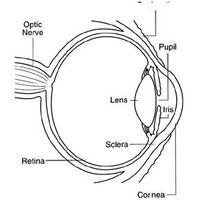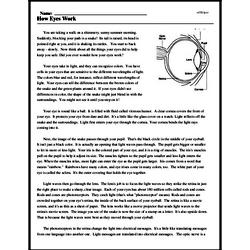How Eyes Work
You are taking a walk on a shimmery, sunny summer morning. Suddenly, blocking your path is a snake! Its tail is raised, its head is pointed right at you, and it is shaking its rattles. You start to back away - slowly. Now think about all the things your eyes did to help keep you safe. Did you ever wonder how your eyes work?
Your eyes take in light, and they can recognize colors. You have cells in your eyes that are sensitive to the different wavelengths of light. The colors blue and red, for instance, reflect different wavelengths of light. Your eyes can tell the difference between the brown colors of the snake and the green plants around it. If your eyes didn't see differences in color, the shape of the snake might just blend in with the surroundings. You might not see it until you step on it!
Your eye is round like a ball. It is filled with fluid called vitreous humor. A clear cornea covers the front of your eye. It protects your eye from dust and dirt. It's a little like the glass cover on a watch. Light reflects off the snake and the surroundings. Light first enters your eye through the cornea. Your cornea bends the light rays coming into it.




